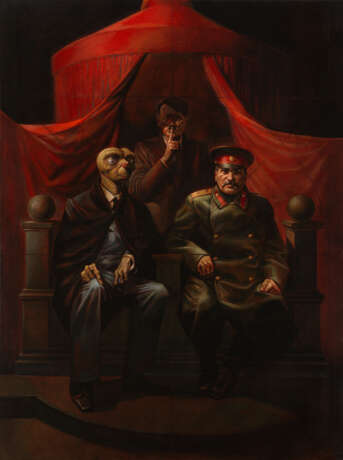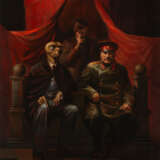KOMAR, VITALY and MELAMID, ALEXANDER (B. 1943 and B. 1945)
07.06.2017 12:30UTC +00:00
Classic
Startpreis
80000GBP £ 80 000
| Auctioneer | MacDougall Arts Ltd. |
|---|---|
| Veranstaltungsort | Vereinigtes Königreich, London |
| Aufgeld | 27 % |
Archiv
Die Auktion ist abgeschlossen. Es können keine Gebote mehr abgegeben werden.

ID 1555
Los 173 *§ | KOMAR, VITALY and MELAMID, ALEXANDER (B. 1943 and B. 1945)
Schätzwert
£ 80 000
Yalta Conference, from the series “Nostalgic Socialist Realism”, signed, inscribed “sketch/proposal” for the Mural/for UN building, NYC” and dated 1982 on the reverse.
Tempera and oil on canvas, 101.5 by 75.5 cm.
80,000-120,000 GBP
Provenance: Acquired directly from V. Komar by the present owner in 2007.
Private collection, USA.
Authenticity of the work has been confirmed by V. Komar.
Exhibited: Glasnost. Soviet Non-Conformist Art from the 1980s, Haunch of Venison, London, 16 April—26 June 2010.
Literature: Exhibition catalogue, J. Backstein, et al, Glasnost. Soviet Non-Conformist Art from the 1980, Manchester, Cornerhouse Publications, 2010, pp. 140–141, illustrated and listed with the wrong size.
Related Literature: For another version of the present lot, see exhibition catalogue, Komar and Melamid, Oxford, Museum of Modern Art, 1985, p. 13, illustrated.
C. Ratcliff, Komar & Melamid, New York, Abbeville Press, 1988, p. 134, pl. 125, illustrated.
B. Groys, The Total Art of Stalinism, New Jersey, Princeton University Press, 1992, illustrated on the cover.
A. Weinstein, Vitaly Komar. Three-Day Weekend, New York, The Humanities Gallery, The Cooper Union for the Advancement of Science and Art, 2005, p. 21, illustrated.
The idea of creating a composition based on the 1945 Yalta Conference occurred to Vitaly Komar and Alexander Melamid, the founding fathers of Sots Art, in the early 1980s. Komar was later to recall: “I think I first saw a photograph from the Yalta Conference in the late 1970s. That photo cast a spell over me. It was banned during the Cold War years. Stalin could not have been sitting next to our enemies. We had defeated Germany without them and in spite of them. Yet here they were, sitting in such a relaxed manner, like relatives – Roosevelt, the democratic president, Stalin, the bloody dictator, and Churchill, the lackey of a monarchy. They were sitting together and deciding how we would organise the future world for the next few years.”
Before long, the artists’ first joint paintings appeared, titled The Yalta Conference (1981–1982), one of which is offered for sale. They depicted Roosevelt, sitting next to Stalin and looking like Spielberg’s E.T. the Extra-Terrestrial – a naïve visitor from another planet who had been moulded by a different political system.
Subsequently, the Yalta series appeared in numerous variations and continuations and was even meant to become part of a mural for the UN building in New York. The subject proved to be so fruitful that it not only gave rise to a celebrated, ambitious installation (1987) and a polyptych (1985–1986), executed by the creative duo, but, after they had parted company, it also inspired Komar to produce the Three-Day Weekend cycle of works (2004–2005), still based on the same photograph of the leaders attending the Yalta Conference.
The picture offered at the auction is unique in that, together with a later canvas that is larger and similar in composition, it has come to be one of the most significant and recognisable works of both Sots Art and of Nonconformist art as a whole. The work is a distillation of the whole of the later project stemming from the 1945 conference. In his well-known book Gesamtkunstwerk Stalin, the philosopher Boris Groys has every reason to say precisely of the project’s idea as the expression of the creative concept of the Komar-Melamid partnership: “In their work The Yalta Conference [sic], Komar and Melamid create a kind of icon of the new trinity that governs the modern subconscious. The figures of Stalin and E.T., which symbolize theutopian spirit dominating both empires, reveal their unity with the nationalsocialist utopia of vanquished Germany. It should be observed here that in all their art Komar and Melamid proceed from this inner kinship between the basic ideological myths of the modern world.”
The painters’ inscription on the back of the canvas – “sketch/proposal” for the Mural/for UN building, NYC” – and the marking out in squares for transferring the composition on to a larger surface show that it was intended to be one of the majestic frescos – a commission that was recalled by the New York City Council. In his interviews later on, Komar pointed out repeatedly that it was the 1982 Yalta Conference composition that should have formed the main part of the project. And Stalin and Roosevelt – national leaders who embodied the political mythology of their time – were, as the artists saw them, turned into a single entity, a combination of man and beast, a present-day monster recalling the hybrids of ancient mythologies. Both the alien and the minotaur (from another composition in the Yalta series – The Minotaur as Participant in the Yalta Conference, 1984–1985) are, as the artists acknowledge, united by a common enemy – the shadowy figure of Hitler that constitutes the substance and the essential reason for the blending into a single whole of a three-headed, many-armed ruler who combines the contradictions between monarchy, tyranny and democracy.
The composition of the 1982 Yalta Conference was one of the first in the famous Nostalgic Socialist Realism series and largely determined not only its conceptual orientation, but also its formal pictorial idea.
Roosevelt’s transformation into the protagonist of Spielberg’s popular film relieves the emotional impact of a picture expressly executed in the academic style of Socialist Realism. The seriousness of the references to prime examples of classical painting turns into obvious irony, and the painting itself is one of the best examples of the work produced by Komar and Melamid.
* Indicates Import Duty Charge applies.
§ Indicates Artists Resale Right applies.
| Adresse der Versteigerung |
MacDougall Arts Ltd. 33 St James’s Square SW1Y 4JS London Vereinigtes Königreich | ||||||||||||||
|---|---|---|---|---|---|---|---|---|---|---|---|---|---|---|---|
| Vorschau |
| ||||||||||||||
| Telefon | +44 20 7389 8160 | ||||||||||||||
| Telefon | +7 495 799 4683 | ||||||||||||||
| Fax | +44 (0) 20 7389 8170 | ||||||||||||||
| Aufgeld | 27 % | ||||||||||||||
| Nutzungsbedingungen | Nutzungsbedingungen | ||||||||||||||
| Geschäftszeiten | Geschäftszeiten
|



